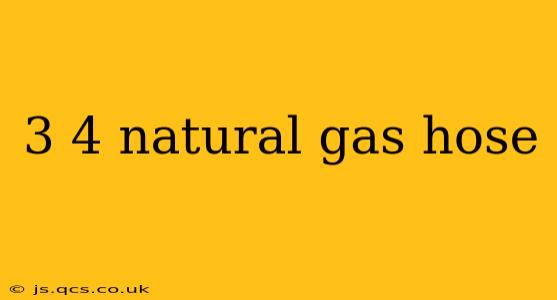Choosing the right natural gas hose is crucial for safety and efficiency. This guide focuses specifically on 3/4" natural gas hoses, explaining their uses, safety considerations, and how to select the appropriate hose for your needs. We'll delve into common questions surrounding these hoses, ensuring you have all the information necessary for safe and informed purchasing.
What is a 3/4" Natural Gas Hose Used For?
A 3/4" natural gas hose is primarily used to connect appliances that require a significant gas flow, such as:
- Large Grills & Outdoor Kitchen Equipment: These appliances often demand a higher gas flow rate than smaller units, making a 3/4" hose necessary for optimal performance.
- Commercial Appliances: Restaurants, industrial kitchens, and other commercial settings may utilize 3/4" hoses to supply gas to larger ovens, ranges, and other high-demand equipment.
- High-Capacity Heaters: Certain outdoor heaters or industrial heating systems require a larger diameter hose to handle the increased gas flow.
- Generator hookups: Some larger generators require a 3/4" connection for natural gas.
It's important to note that the hose's diameter is crucial. Using an undersized hose can restrict gas flow, leading to inefficient operation and potential safety hazards. Always check the appliance's specifications to ensure compatibility before purchasing a hose.
What are the Different Types of 3/4" Natural Gas Hoses?
Several types of 3/4" natural gas hoses exist, each with unique characteristics:
- Flexible Metal Hoses: These are highly durable and resistant to kinking, but can be more expensive than other options. They typically feature a braided stainless steel exterior for enhanced protection.
- Rubber Hoses: More affordable than metal hoses, rubber hoses are flexible but may be less durable and susceptible to damage from abrasion or extreme temperatures. It is essential to ensure that the rubber hose is specifically rated for natural gas and meets all relevant safety standards.
- Reinforced Rubber Hoses: Combining the flexibility of rubber with added reinforcement, these hoses offer a balance of durability and cost-effectiveness. The reinforcement layer enhances resistance to wear and tear.
What is the Length of a Typical 3/4" Natural Gas Hose?
The length of a 3/4" natural gas hose varies depending on the application. Lengths commonly range from a few feet to several tens of feet, depending on the distance between the gas source and the appliance. Always select a hose that's long enough to accommodate the connection comfortably without stretching or straining. Excessive stretching can damage the hose and create a potential leak risk.
How Do I Choose the Right 3/4" Natural Gas Hose?
Choosing the right hose depends on several factors:
- Appliance Requirements: Always consult the appliance's specifications to determine the correct hose diameter, length, and connection type.
- Durability Needs: Consider the environment and frequency of use. For harsh conditions or frequent use, a more durable metal hose may be preferable.
- Budget: Rubber hoses generally offer a more budget-friendly option, while metal hoses represent a higher initial investment.
- Safety Certifications: Ensure the hose carries the appropriate safety certifications, such as those from organizations like CSA or AGA, to guarantee its compliance with safety standards.
What Safety Precautions Should I Take When Using a 3/4" Natural Gas Hose?
Safety should always be a top priority when working with natural gas. Follow these essential precautions:
- Regular Inspection: Inspect the hose regularly for signs of damage, such as cracks, kinks, or leaks. Replace any damaged hose immediately.
- Proper Connections: Ensure all connections are secure and tight to prevent leaks. Use appropriate fittings and follow manufacturer instructions carefully.
- Ventilation: Adequate ventilation is essential, especially in enclosed spaces, to prevent the buildup of potentially harmful gases.
- Leak Detection: Use a leak detection solution or tool to check for leaks before and after connecting the hose.
- Professional Installation: For complex installations or if you are unsure about any aspect of the process, it is always recommended to seek professional help from a qualified gas technician.
By following these guidelines and prioritizing safety, you can ensure the safe and efficient use of your 3/4" natural gas hose. Remember to consult professional help when needed.
